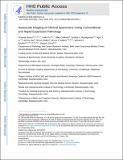Nanoscale imaging of clinical specimens using conventional and rapid-expansion pathology
Author(s)
Bucur, Octavian; Fu, Feifei; Calderon, Mike; Mylvaganam, Geetha H; Ly, Ngoc L; Day, Jimmy; Watkin, Simon; Walker, Bruce D; Boyden, Edward S; Zhao, Yongxin; ... Show more Show less
DownloadAccepted version (4.185Mb)
Publisher Policy
Publisher Policy
Article is made available in accordance with the publisher's policy and may be subject to US copyright law. Please refer to the publisher's site for terms of use.
Terms of use
Metadata
Show full item recordAbstract
© 2020, The Author(s), under exclusive licence to Springer Nature Limited. In pathology, microscopy is an important tool for the analysis of human tissues, both for the scientific study of disease states and for diagnosis. However, the microscopes commonly used in pathology are limited in resolution by diffraction. Recently, we discovered that it was possible, through a chemical process, to isotropically expand preserved cells and tissues by 4–5× in linear dimension. We call this process expansion microscopy (ExM). ExM enables nanoscale resolution imaging on conventional microscopes. Here we describe protocols for the simple and effective physical expansion of a variety of human tissues and clinical specimens, including paraffin-embedded, fresh frozen and chemically stained human tissues. These protocols require only inexpensive, commercially available reagents and hardware commonly found in a routine pathology laboratory. Our protocols are written for researchers and pathologists experienced in conventional fluorescence microscopy. The conventional protocol, expansion pathology, can be completed in ~1 d with immunostained tissue sections and 2 d with unstained specimens. We also include a new, fast variant, rapid expansion pathology, that can be performed on <5-µm-thick tissue sections, taking <4 h with immunostained tissue sections and <8 h with unstained specimens.
Date issued
2020Department
Massachusetts Institute of Technology. Media Laboratory; Massachusetts Institute of Technology. Institute for Medical Engineering & Science; Massachusetts Institute of Technology. Department of Brain and Cognitive Sciences; Massachusetts Institute of Technology. Department of Biological Engineering; McGovern Institute for Brain Research at MIT; Koch Institute for Integrative Cancer Research at MIT; Massachusetts Institute of Technology. Center for Neurobiological EngineeringJournal
Nature Protocols
Publisher
Springer Science and Business Media LLC
Citation
Bucur, Octavian, Fu, Feifei, Calderon, Mike, Mylvaganam, Geetha H, Ly, Ngoc L et al. 2020. "Nanoscale imaging of clinical specimens using conventional and rapid-expansion pathology." Nature Protocols, 15 (5).
Version: Author's final manuscript